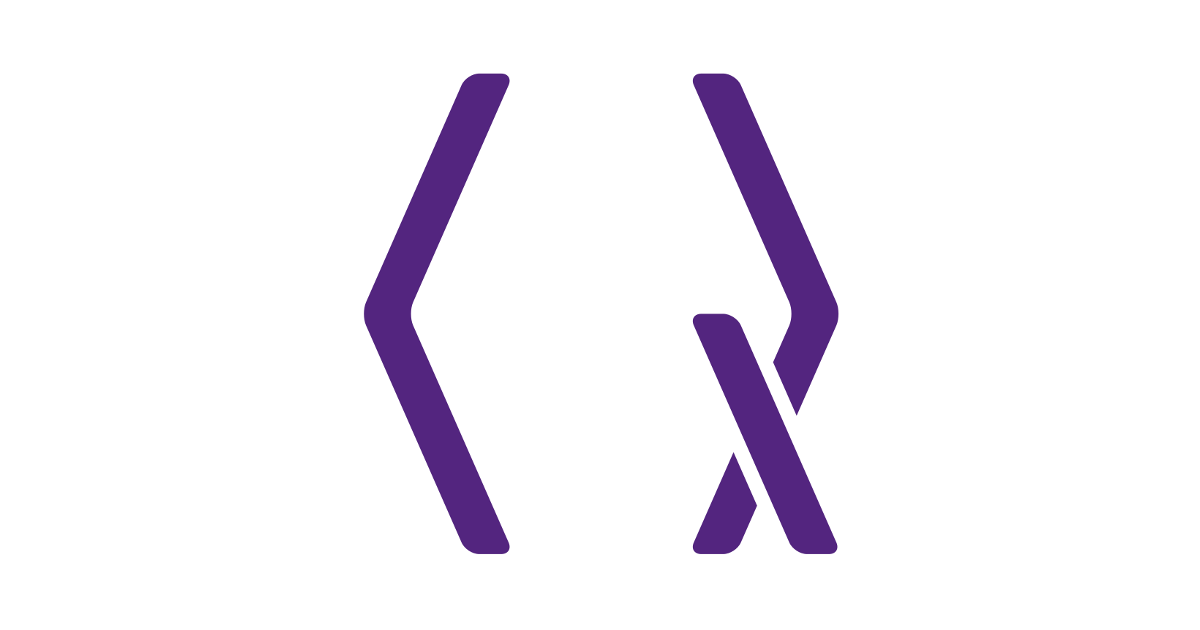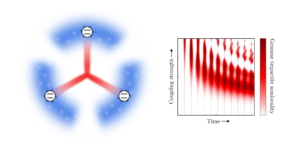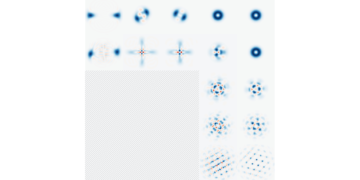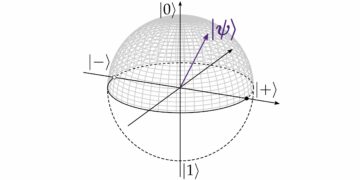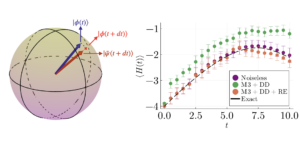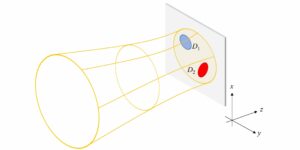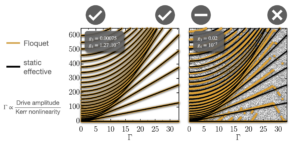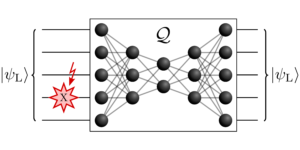1School of Mathematical Sciences, Institute of Natural Sciences, MOE-LSEC and SHL-MAC, Shanghai Jiao Tong University, Shanghai, China
2Department of Mathematics, Pennsylvania State University, University Park, PA 16802, USA
3Institute of Natural Sciences, University of Michigan-Shanghai Jiao Tong University Joint Institute, MOE-LSEC, Shanghai Jiao Tong University, Shanghai, China
Find this paper interesting or want to discuss? Scite or leave a comment on SciRate.
Abstract
Solving the time-dependent Schrödinger equation is an important application area for quantum algorithms. We consider Schrödinger’s equation in the semi-classical regime. Here the solutions exhibit strong multiple-scale behavior due to a small parameter $hbar$, in the sense that the dynamics of the quantum states and the induced observables can occur on different spatial and temporal scales. Such a Schrödinger equation finds many applications, including in Born-Oppenheimer molecular dynamics and Ehrenfest dynamics. This paper considers quantum analogues of pseudo-spectral (PS) methods on classical computers. Estimates on the gate counts in terms of $hbar$ and the precision $varepsilon$ are obtained. It is found that the number of required qubits, $m$, scales only logarithmically with respect to $hbar$. When the solution has bounded derivatives up to order $ell$, the symmetric Trotting method has gate complexity $mathcal{O}Big({ (varepsilon hbar)^{-frac12} mathrm{polylog}(varepsilon^{-frac{3}{2ell}} hbar^{-1-frac{1}{2ell}})}Big),$ provided that the diagonal unitary operators in the pseudo-spectral methods can be implemented with $mathrm{poly}(m)$ operations. When physical observables are the desired outcomes, however, the step size in the time integration can be chosen independently of $hbar$. The gate complexity in this case is reduced to $mathcal{O}Big({varepsilon^{-frac12} mathrm{polylog}( varepsilon^{-frac3{2ell}} hbar^{-1} )}Big),$ with $ell$ again indicating the smoothness of the solution.
► BibTeX data
► References
[1] Shi Jin, Peter Markowich, and Christof Sparber. “Mathematical and computational methods for semiclassical Schrödinger equations”. Acta Numerica 20, 121–209 (2011). doi: https://doi.org/10.1017/S0962492911000031.
https://doi.org/10.1017/S0962492911000031
[2] Max Born and Robert Oppenheimer. “Zur quantentheorie der molekeln”. Annalen der physik 389, 457–484 (1927). doi: https://doi.org/10.1002/andp.19273892002.
https://doi.org/10.1002/andp.19273892002
[3] John C Tully. “Molecular dynamics with electronic transitions”. The Journal of Chemical Physics 93, 1061–1071 (1990). doi: https://doi.org/10.1063/1.459170.
https://doi.org/10.1063/1.459170
[4] Clarence Zener. “Non-adiabatic crossing of energy levels”. Proceedings of the Royal Society of London. Series A, Containing Papers of a Mathematical and Physical Character 137, 696–702 (1932). doi: https://doi.org/10.1098/rspa.1932.0165.
https://doi.org/10.1098/rspa.1932.0165
[5] Folkmar A Bornemann, Peter Nettesheim, and Christof Schütte. “Quantum-classical molecular dynamics as an approximation to full quantum dynamics”. The Journal of chemical physics 105, 1074–1083 (1996). doi: https://doi.org/10.1063/1.471952.
https://doi.org/10.1063/1.471952
[6] Karen Drukker. “Basics of surface hopping in mixed quantum/classical simulations”. Journal of Computational Physics 153, 225–272 (1999). doi: https://doi.org/10.1006/jcph.1999.6287.
https://doi.org/10.1006/jcph.1999.6287
[7] Juergen Hinze. “MC-SCF. I. the multi-configuration self-consistent-field method”. The Journal of Chemical Physics 59, 6424–6432 (1973). doi: https://doi.org/10.1063/1.1680022.
https://doi.org/10.1063/1.1680022
[8] Weizhu Bao, Shi Jin, and Peter A Markowich. “On time-splitting spectral approximations for the Schrödinger equation in the semiclassical regime”. Journal of Computational Physics 175, 487–524 (2002). doi: https://doi.org/10.1006/jcph.2001.6956.
https://doi.org/10.1006/jcph.2001.6956
[9] Andrew M Childs, Yuan Su, Minh C Tran, Nathan Wiebe, and Shuchen Zhu. “Theory of Trotter error with commutator scaling”. Physical Review X 11, 011020 (2021). doi: https://doi.org/10.1103/PhysRevX.11.011020.
https://doi.org/10.1103/PhysRevX.11.011020
[10] François Golse, Shi Jin, and Thierry Paul. “On the convergence of time splitting methods for quantum dynamics in the semiclassical regime”. Foundations of Computational Mathematics 21, 613–647 (2021). doi: https://doi.org/10.1007/s10208-020-09470-z.
https://doi.org/10.1007/s10208-020-09470-z
[11] Caroline Lasser and Christian Lubich. “Computing quantum dynamics in the semiclassical regime”. Acta Numerica 29, 229–401 (2020). doi: https://doi.org/10.1017/S0962492920000033.
https://doi.org/10.1017/S0962492920000033
[12] Haruo Yoshida. “Construction of higher order symplectic integrators”. Physics letters A 150, 262–268 (1990). doi: https://doi.org/10.1016/0375-9601(90)90092-3.
https://doi.org/10.1016/0375-9601(90)90092-3
[13] Ryan Babbush, Nathan Wiebe, Jarrod McClean, James McClain, Hartmut Neven, and Garnet Kin-Lic Chan. “Low-depth quantum simulation of materials”. Physical Review X 8, 011044 (2018). doi: https://doi.org/10.1103/PhysRevX.8.011044.
https://doi.org/10.1103/PhysRevX.8.011044
[14] Christof Zalka. “Efficient simulation of quantum systems by quantum computers”. Fortschritte der Physik: Progress of Physics 46, 877–879 (1998). doi: https://doi.org/10.1098/rspa.1998.0162.
https://doi.org/10.1098/rspa.1998.0162
[15] Stephen Wiesner. “Simulations of many-body quantum systems by a quantum computer” (1996).
[16] Nicholas J Ward, Ivan Kassal, and Alán Aspuru-Guzik. “Preparation of many-body states for quantum simulation”. The Journal of chemical physics 130, 194105 (2009). doi: https://doi.org/10.1063/1.3115177.
https://doi.org/10.1063/1.3115177
[17] Vivek V Shende, Stephen S Bullock, and Igor L Markov. “Synthesis of quantum-logic circuits”. IEEE Transactions on Computer-Aided Design of Integrated Circuits and Systems 25, 1000–1010 (2006). doi: https://doi.org/10.1109/TCAD.2005.855930.
https://doi.org/10.1109/TCAD.2005.855930
[18] Stephen S Bullock and Igor L Markov. “Asymptotically optimal circuits for arbitrary n-qubit diagonal computations”. Quantum Information & Computation 4, 27–47 (2004).
[19] Norbert Schuch and Jens Siewert. “Programmable networks for quantum algorithms”. Physical review letters 91, 027902 (2003). doi: https://doi.org/10.1103/PhysRevLett.91.027902.
https://doi.org/10.1103/PhysRevLett.91.027902
[20] Guang Hao Low and Nathan Wiebe. “Hamiltonian simulation in the interaction picture” (2018). https://arxiv.org/abs/1805.00675v2.
arXiv:1805.00675v2
[21] Ivan Kassal, Stephen P Jordan, Peter J Love, Masoud Mohseni, and Alán Aspuru-Guzik. “Polynomial-time quantum algorithm for the simulation of chemical dynamics”. Proceedings of the National Academy of Sciences 105, 18681–18686 (2008). doi: https://doi.org/10.1073/pnas.0808245105.
https://doi.org/10.1073/pnas.0808245105
[22] Yu Tong, Dong An, Nathan Wiebe, and Lin Lin. “Fast inversion, preconditioned quantum linear system solvers, fast Green’s-function computation, and fast evaluation of matrix functions”. Physical Review A 104, 032422 (2021). doi: https://doi.org/10.1103/PhysRevA.104.032422.
https://doi.org/10.1103/PhysRevA.104.032422
[23] Dominic W Berry, Andrew M Childs, Richard Cleve, Robin Kothari, and Rolando D Somma. “Exponential improvement in precision for simulating sparse Hamiltonians”. In Forum of Mathematics, Sigma. Volume 5. Cambridge University Press (2017). doi: https://doi.org/10.1017/fms.2017.2.
https://doi.org/10.1017/fms.2017.2
[24] Stéphane Descombes and Mechthild Thalhammer. “An exact local error representation of exponential operator splitting methods for evolutionary problems and applications to linear Schrödinger equations in the semi-classical regime”. BIT Numerical Mathematics 50, 729–749 (2010). doi: https://doi.org/10.1007/s10543-010-0282-4.
https://doi.org/10.1007/s10543-010-0282-4
[25] Peter A Markowich, Paola Pietra, and Carsten Pohl. “Numerical approximation of quadratic observables of schrödinger-type equations in the semi-classical limit”. Numerische Mathematik 81, 595–630 (1999). doi: https://doi.org/10.1007/s002110050406.
https://doi.org/10.1007/s002110050406
[26] William J Huggins, Kianna Wan, Jarrod McClean, Thomas E O’Brien, Nathan Wiebe, and Ryan Babbush. “Nearly optimal quantum algorithm for estimating multiple expectation values” (2021). Nearly optimal quantum algorithm for estimating multiple expectation values.
[27] Joseph E Pasciak. “Spectral and pseudospectral methods for advection equations”. Mathematics of Computation 35, 1081–1092 (1980). doi: https://doi.org/10.1090/S0025-5718-1980-0583488-0.
https://doi.org/10.1090/S0025-5718-1980-0583488-0
[28] Daniel Koch, Laura Wessing, and Paul M Alsing. “Introduction to coding quantum algorithms: A tutorial series using Qiskit” (2019). https://arxiv.org/abs/2111.09283.
arXiv:2111.09283
[29] Robert Wille, Rod Van Meter, and Yehuda Naveh. “IBM’s Qiskit tool chain: Working with and developing for real quantum computers”. In 2019 Design, Automation & Test in Europe Conference & Exhibition (DATE). Pages 1234–1240. IEEE (2019). doi: https://doi.org/10.23919/DATE.2019.8715261.
https://doi.org/10.23919/DATE.2019.8715261
[30] David S Sholl and John C Tully. “A generalized surface hopping method”. The Journal of chemical physics 109, 7702–7710 (1998). doi: https://doi.org/10.1063/1.477416.
https://doi.org/10.1063/1.477416
[31] Shi Jin, Peng Qi, and Zhiwen Zhang. “An Eulerian surface hopping method for the Schrödinger equation with conical crossings”. Multiscale Modeling & Simulation 9, 258–281 (2011). doi: https://doi.org/10.1137/090774185.
https://doi.org/10.1137/090774185
[32] Atsushi Ishikawa, Hiroyuki Nakashima, and Hiroshi Nakatsuji. “Accurate solutions of the Schrödinger and dirac equations of h2+, hd+, and ht+: With and without Born–Oppenheimer approximation and under magnetic field”. Chemical Physics 401, 62–72 (2012). doi: https://doi.org/10.1016/j.chemphys.2011.09.013.
https://doi.org/10.1016/j.chemphys.2011.09.013
[33] Aram W. Harrow, Avinatan Hassidim, and Seth Lloyd. “Quantum algorithm for solving linear systems of equations”. Physical Review Letters 103, 150502 (2009). doi: https://doi.org/10.1103/PhysRevLett.103.150502.
https://doi.org/10.1103/PhysRevLett.103.150502
[34] Andrew M Childs, Robin Kothari, and Rolando D Somma. “Quantum algorithm for systems of linear equations with exponentially improved dependence on precision”. SIAM Journal on Computing 46, 1920–1950 (2017). doi: https://doi.org/10.1137/16M1087072.
https://doi.org/10.1137/16M1087072
[35] Andrew M Childs and Jin-Peng Liu. “Quantum spectral methods for differential equations”. Communications in Mathematical Physics 375, 1427–1457 (2020). doi: https://doi.org/10.1007/s00220-020-03699-z.
https://doi.org/10.1007/s00220-020-03699-z
[36] Jean-Pierre Petit. “An interpretation of cosmological model with variable light velocity”. Modern Physics Letters A 3, 1527–1532 (1988). doi: https://doi.org/10.1142/S0217732388001823.
https://doi.org/10.1142/S0217732388001823
Cited by
[1] Andrew M. Childs, Jiaqi Leng, Tongyang Li, Jin-Peng Liu, and Chenyi Zhang, “Quantum simulation of real-space dynamics”, arXiv:2203.17006.
The above citations are from SAO/NASA ADS (last updated successfully 2022-07-16 22:40:53). The list may be incomplete as not all publishers provide suitable and complete citation data.
On Crossref’s cited-by service no data on citing works was found (last attempt 2022-07-16 22:40:51).
This Paper is published in Quantum under the Creative Commons Attribution 4.0 International (CC BY 4.0) license. Copyright remains with the original copyright holders such as the authors or their institutions.

